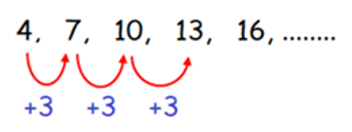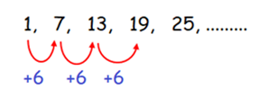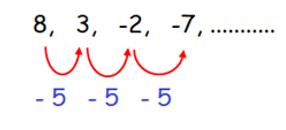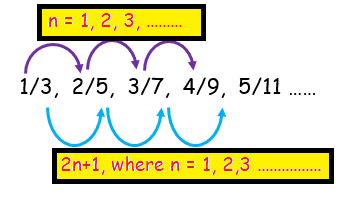HOW TO DETERMINE THE RULE OF A SEQUENCE
The sequence is the number arrangements, that follows a particular rule. By analyzing the sequence given we can find the rule followed in the sequence.
Find the rule which will generate the sequence :
Example 1 :
4, 7, 10, 13, 16, ……
Solution :

By observing the sequence above, every term is
added by +3
to get the next term of the sequence.
Example 2 :
- 2, 3, 8, 13, 18, ……
Solution :

By observing the sequence above, every term is
added by +5
to get the next term of the sequence.
Example 3 :
1, 7, 13, 19, 25, ……
Solution :

By observing the sequence above, every term is
added by +6
to get the next term of the sequence.
Example 4 :
3, 10, 17, 24, 31, ……
Solution :

By observing the sequence above, every term is
added by +7
to get the next term of the sequence.
Example 5 :
40, 37, 34, 31, ……
Solution :

By observing the sequence above, every term is
subtracted by -3
to get the next term of the sequence.
Example 6 :
76, 72, 68, 64, ……
Solution :

By observing the sequence above, every term is
subtracted by -4
to get the next term of the sequence.
Example 7 :
8, 3, -2, -7, ……
Solution :

By observing the sequence above, every term is
subtracted by -5
to get the next term of the sequence.
Example 8 :
127, 121, 115, 109, ……
Solution :

By observing the sequence above, every term is
subtracted by -6
to get the next term of the sequence.
Example 9 :
1/3, 2/5, 3/7, 4/9, 5/11 ……
Solution :
By observing the given sequence,
numerators = consecutive numbers
denominators = odd numbers

Numerator :
If n be the numerator,
n = natural numbers starts with 1
Denominator :
odd numbers = starts with 3
denominator = 2n+1
n = 1, 2, 3,........
2n+1 = 3, 5, 7, .......
So, the rule is n/(2n+1)
Example 10 :
Four sequences A, B, C and D are defined by the following formulae
A : Un = 8n + 2
B : Un = 7n - 3
C : Un = 3n + 1
D : Un = 100 - 6n
a) Which sequence have 4 as their first term ?
b) Which sequence is decreasing ?
c) Which sequence has a difference of 7 between terms ?
d) Which sequence has 301 as its 100th term ?
Solution :
a) Let us find the first term of the sequence B.
B : Un = 7n - 3
To find the first term, let us apply n = 1
U1 = 7(1) - 3
= 7 - 3
U1 = 4
b) By observing the rules of each sequence, from the initial value 100 some quantity is subtracted every time. To confirm this, let us find some of the terms.
D : Un = 100 - 6n
|
Un = 100 - 6n When n = 1 = 100 - 6(1) = 100 - 6 = 94 |
Un = 100 - 6n When n = 2 = 100 - 6(2) = 100 - 12 = 88 |
Un = 100 - 6n When n = 3 = 100 - 6(3) = 100 - 18 = 82 |
So, sequence D is the decreasing sequence.
c) Let us find first three terms of the sequence B,
Un = 7n - 3
|
Un = 7n - 3 When n = 1 = 7(1) - 3 = 7 - 3 = 4 |
Un = 7n - 3 When n = 2 = 7(2) - 3 = 14 - 3 = 11 |
Un = 7n - 3 When n = 3 = 7(3) - 3 = 21 - 3 = 18 |
So, in sequence B the difference between two terms is 7
d) Let us find the 100th term in sequence C.
C : Un = 3n + 1
When n = 100
U100 = 3(100) + 1
= 300 + 1
= 301
So, 100th term of sequence C is 301.
Example 11 :
Look at the part of the number line, write down the 2 missing numbers.

Copy and complete the sentence
The numbers on this line go up in steps of _______
Solution :
-7, ____, 1, 5, 9, _____, 17
By observing 1, 5 and 9 every term is increased by 4. Then after 9, we have to add 4 by 9. Then 14 is the term after 9.
Before 1, we have to decrease 4, then 1 - 4 = -3. So, after -7 we have -3.
Then the missing terms are -3 and 14.
Example 12 :
Jeff makes a sequence of patterns with black and grey triangular tiles.

The rule of finding the number of tiles pattern number N in Jeff's sequence is
Number of tiles = 1 + 3N
i) The 1 in this rule represents the black tile. What does the 3N represent ?
ii) Jeff makes pattern number 12 in this sequence. How many black tiles and how many grey tiles does he use ?
iii) Jeff uses 61 tiles altogether to make a pattern in his sequence, what is the number of pattern he makes ?
Solution :
i) Here by observing the pattern, 3N says the number of grey tiles.
ii) Number of tiles = 1 + 3N
To find number of tiles in the 12th pattern, we have to apply N = 12
Number of tiles = 1 + 3(12)
= 1 + 36
= 37
So, in the 12th pattern number of black tiles is 1 and number of grey tiles = 36.
iii) When number of tiles = 61
61 = 1 + 3N
61 - 1 = 3N
3N = 60
N = 60/3
N = 20
So, total number of tiles in the 20th pattern is 61.
Kindly mail your feedback to v4formath@gmail.com
We always appreciate your feedback.
©All rights reserved. onlinemath4all.com
Recent Articles
-
Rational Root Theorem
Feb 06, 25 07:42 PM
Rational Root Theorem or Rational Zero Theorem - Concept - Examples -
How to Find Pythagorean Triplet from One Number
Feb 06, 25 06:10 PM
How to Find Pythagorean Triplet from One Number - Concept - Examples with step by step explanation -
AP Calculus AB Problems with Solutions (Part - 10)
Feb 06, 25 09:46 AM
AP Calculus AB Problems with Solutions (Part - 10)

